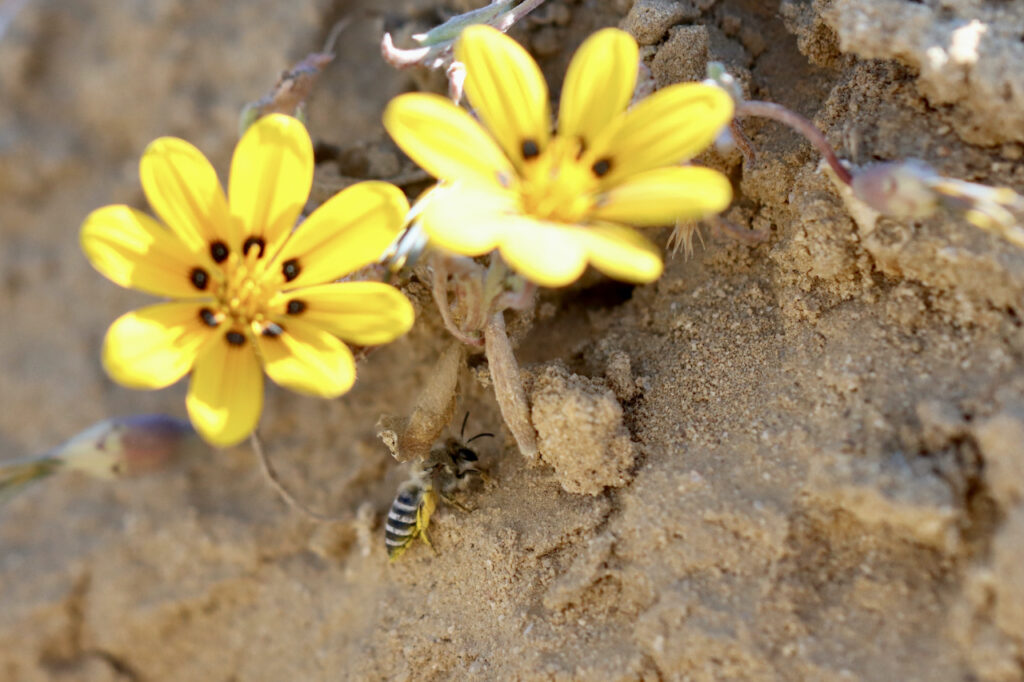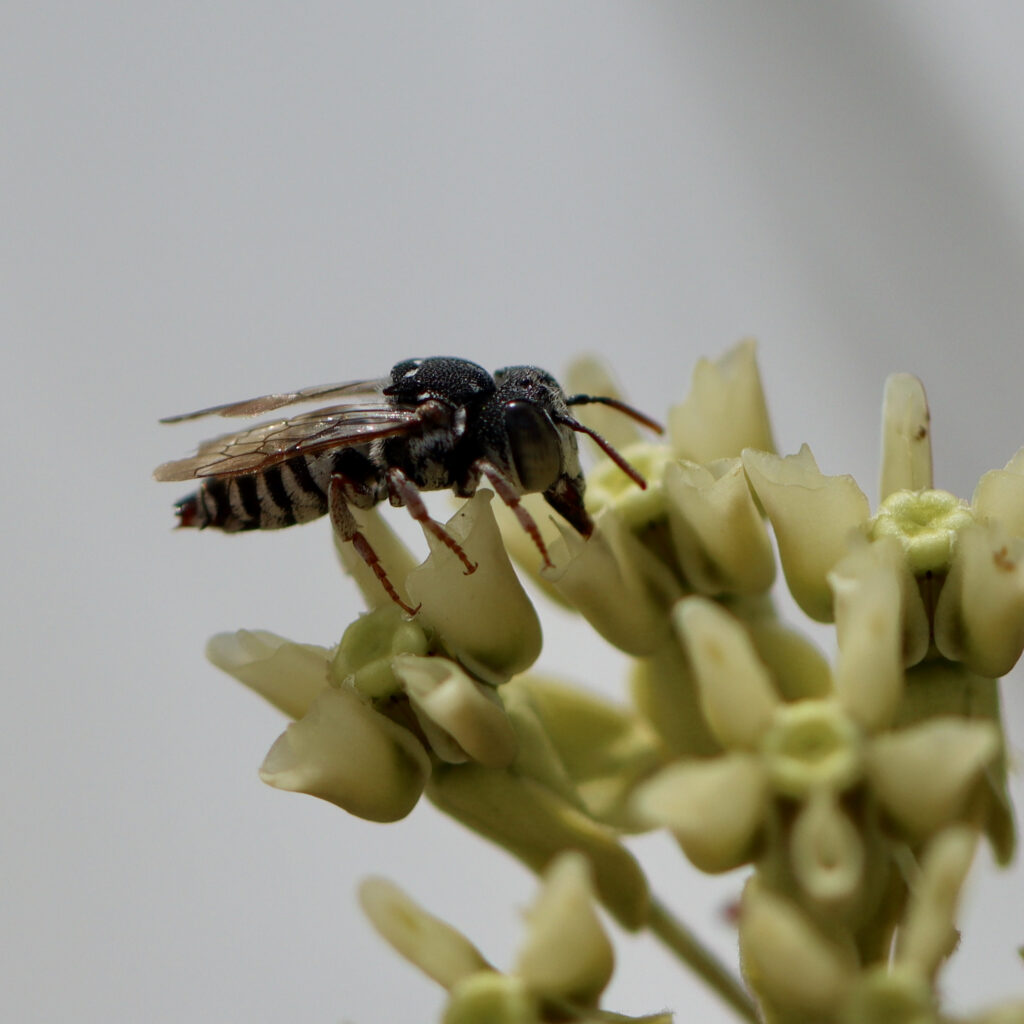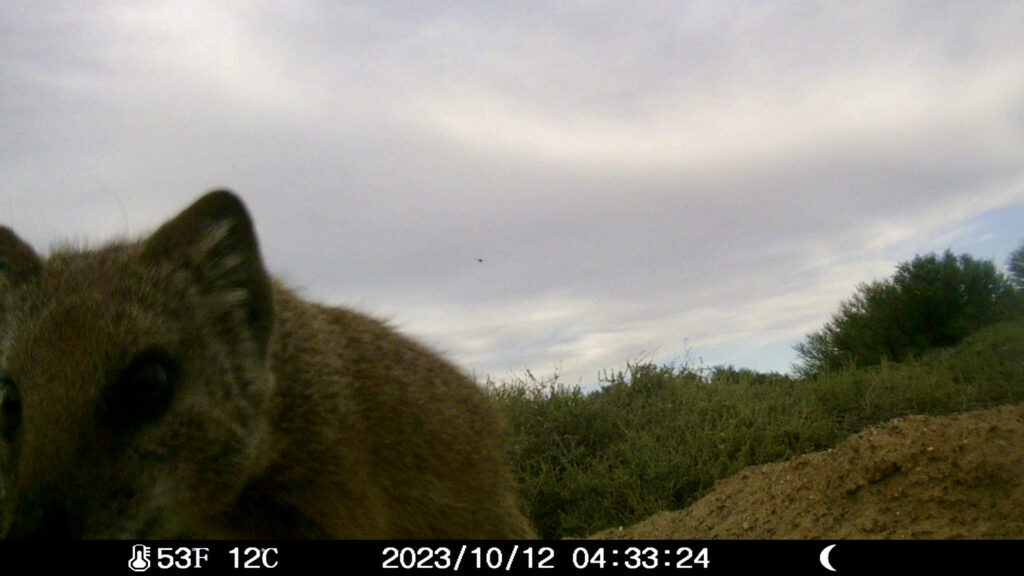Occasionally, biodiversity might just be thriving beneath our feet.

The resilient Karoo landscape
During my explorations of the Wolwekraal Nature Reserve, in the arid Karoo region of South Africa, a seemingly desolate stretch of land consistently caught my attention. This area, characterised by hard, ancient sediment, served as a shortcut from the jeep tracks to a wild colony of honeybees nesting in an aardvark (antbear) burrow. The flora surrounding this bare ground is a stark reminder of the Karoo’s remarkable resilience, showcasing a rich tapestry of species that thrive in one of the world’s extreme climates. Over centuries, the vegetation here has adapted to withstand dramatic temperature fluctuations, from severe winter frosts to scorching summer heat at times exceeding 50°C, often enduring prolonged periods of drought.
Yet, amid this tenacity, certain areas of the landscape remain barren and hardened. Recently, I buried a wild hare—a tragic victim of roadkill—in an aardvark dugout; a deep, empty cavity, in an area of hard ground I could never have dug myself. My sister, with her characteristic humour, had remarked, “Everyone needs an aardvark.” As I reflected on the hare’s untimely death, I was once again captivated by the number of solitary bees nesting in holes on the inner edges of these burrows. Like the wild honeybees in these landscapes, many species are dependent on the :aardvark for their nest sites; a reminder of nature’s interconnectedness. All around the dugout vibrant yellow swathes of Gazania lichtensteinii were in flower, their annual beauty enhanced by early winter rains.
Top row left to right, solitary bees living on the edge of this aardvark dugout: Samba female, Colletes female, and a Patellapis female.
Misconceptions of bare ground
The seemingly lifeless stretch of ground, a wind-scoured deflation hollow, was located close to this dugout. Deflation hollows form where vegetation is lost allowing wind to remove sandy topsoil and expose a hard subsoil comprising desert dust cemented with calcium carbonate. They are often associated with stone age human settlements of hunter-gatherers and herders. At this particular deflation hollow, there are various stone tools made from chert including a stone arrowhead. Standing on this hardened ground I was struck by a common misconception: that bare earth signifies death. Often dismissed in environmental assessments, this apparently barren, hard ground was, in fact, teeming with life and intrigue. Initially mistaking the sounds I was hearing for a drone congregation area – where honeybee males dart through the sky waiting for a queen – I quickly realised that the sound was emanating from the ground. A closer look revealed a fascinating gathering of male Tetraloniella cf. brevikeraia bees. These short-horned longhorn solitary bees were eagerly vying for a chance to mate with a female as she emerged from her underground nest. Although solitary by nature—females work alone in building nests and provisioning food—these bees form dense aggregations in favourable environments. The apparent barrenness of the ground belied its role as a prime breeding ground, and I counted an astonishing 114 nests in the vicinity.

The evolutionary journey of bees
The evolutionary journey of bees, stretching back around 100 million years, began with solitary, predatory mud-dauber wasps, coinciding with the rise of flowering plants. Today, bees exhibit remarkable diversity, particularly in arid regions such as the Karoo where solitary species thrive. They range in size from a mere 2mm to 39mm and come in various forms, from densely hairy to smooth and shiny, often adorned with striking colours, masks, stripes and patterns. Most species of solitary bees prefer to nest in the ground, often using plant materials or resin to line their nests. On this hard bare ground, the thriving community of Tetraloniella served as a vivid testament to the vibrant life hidden beneath the surface.
Dynamics on the deflation hollow
The deflation hollow measured 24 m by 13 m, with nests concentrated in a mere twelve square meters. The spacing of the nests varied, with some holes nearly touching while others were separated by more than 20 cm. The solitary male bees, have one primary role: to mate. Males are remarkably specialised, with their entire existence revolving around this singular task. To prepare for mating in the earlier hours of the day with temperatures in the lower teens, the males press their bodies against the sun-warmed sand. In September, when daytime temperatures can reach 28°C, the ground can heat up to a hot 44°C. Males dart close to the surface in circular and zigzag patterns, seeking the radiated warmth that boosts their speed. I counted 26 males on this day, but their numbers waned with each subsequent day. I could only imagine how busy this aggregation had been at the beginning of mating season. Many of the males were covered in bright yellow gazania pollen from hasty sips of nectar essential for their energy needs.

Top row: Shortly after 9 a.m., the first male Tetraloniella bees make their appearance on the deflation hollow, braving air temperatures below 15°C. Seeking warmth, they press their bodies against the sun-soaked sand, where ground temperatures already reach the mid-20s. Middle + bottom row: Males congregating around the nest holes, waiting for the females to emerge
Coexisting species: The diversity of life
In addition to the Tetraloniella bees, there were other bees thriving in this environment. Among them were various species of leafcutter, dauber and mason bees (Megachilidae) that make their nests in pre-existing burrows. Initially chased by the males, they started inspecting holes abandoned after the females emerged. These bees possess unique nesting techniques and have the broadest range of nesting behaviours. Unlike honeybees that collect pollen on their hind legs, the Megachilidae collect pollen on tufts of red hairs on the underside of their abdomen, known as a scopa. When this is fully packed with pollen it is a bright patch of colour.
Leafcutter bees construct thimble-like cells lined with leaves or petals to protect their young from moisture and predators. For their nests they were using both leaves of krimpsiektebos (Lessertia annularis) as well as gazania petals. Both of these plants contain extremely bitter compounds that possibly serve to deter parasites and provide beneficial antimicrobial properties. Another of the females (Hoplitis sp.) used chewed, reddish-pink plant pulp together with a mouth secretion to line her burrow. The source of the plant was not established but was similar in colour to bellbush (Hermannia grandiflora) flowering nearby. Similarly diverse are the materials used for plugging the entrances, with some bees choosing a combination of leaf pieces and mud, while others used mud and stones. The collected pollens for the provision of larvae with food came from plants distinct from those used for nesting materials, possibly from honeybush (Melobium candicans) or the brightfig (Rushia bijliae), both in flower and in range of the nest site and on which the bees were sighted. Each female completed one burrow per day.
Megachilid bees with their diverse nesting techniques, utilising burrows abandoned by Tetraloniella bees
Further careful study of the ground revealed a Camponotus rufopilosis (balbyter) ant carrying a dead conspecific. With mandibles featuring 5 to 7 teeth, these ants defend themselves by spraying formic acid when threatened. Amidst the male Tetraloniella bees, this ant dropped its prey and assumed a defensive stance. Larger, robust dauber bees (Megachile nasicornis) were also sighted, distinguished by their different, deeper sounds, and by their striking, singular patches of black and white coloration. They were also on the lookout for abandoned Tetraloniella nests to use for their own reproduction.
Balbyter ants (Camponotus rufopilosis) and the larger, more robust, dauber bees (Megachile nasicornis) on the deflation hollow
While documenting these interactions, a brown-and-white striped fly (probably in the genus Parisus) scraped her abdomen along the ground and then hovered above several bee nest holes. This Bombyliidae fly is known to parasitise a range of insects including bees. Hovering above a nest, the fly deposited 33 eggs in less than a minute. To lay eggs in this way, some Bombyliidae have a chamber near the ovipositor filled with sand which they stick to the egg, giving it enough weight to shoot deeper into the host nest and helping to prevent the egg from drying out too much. This observation might represent a new host record, and underscores the intricate relationships between host and parasite.
Top row left to right: A Bombyliid fly filling her ovipositor with sand granules, then hovering over a nest burrow to lay eggs. Bottom row left to right: A male Tetraloniella bee investigating the fly; the fly shooting an egg into the burrow (spot the egg!)
A climax
The climax of my observations came when a chaotic scrum formed around a single nest hole, where male bees gathered in a frenzied attempt to mate with the emerging virgin female. In this state where the males were fixated on the hole and seemed vulnerable to predation, I wondered if the female released a pheromone to signal her arrival. As mating commenced, the male produced a sound known as “piping,” a result of the vibrations created by the wing muscles. The male, mounted on the female, used his antennae to possibly release a volatile pheromone, engaging in a behaviour known as antennal fanning. He fans his antennae near hers without direct contact. Research indicates that a courtship pheromone may exist in bees, which is believed to induce receptiveness in the female. Clasped tightly to her, other males attempted to dislodge him, displaying a complex mating struggle. Uniquely, the female grasped a red stone during copulation, remaining mostly still amidst the chaos around her. After more than 3 minutes of mating the primary male was dislodged, and the female executed an intense spinning motion to escape, eventually flying off to establish a new nest elsewhere. (To watch the incredible mating video, click here.)
Top: A scrum of males around the hole where the female is about to emerge. Top right and middle: a tussle ensues as one male battles another for the opportunity to mate with the female. Bottom: the mating pair.
I was unable to establish the mode of excavation of the nests, or whether this species use pre-existing nest cavities as the Megachilidae do, though did note that no turrets or soil mounds were present. Similarly, I could not locate the males at night, though these are thought to form sleeping clusters hanging from a branch.
A rich tapestry of creatures
While at the study site, I encountered numerous other creatures. Among them were a rock agama, Namaqua sand lizards, cryptic Sphingonotis grasshoppers, beetles, robber flies (Asilidae), and a wingless female mutillid wasp (velvet ant). This ant-mimicking wasp was intriguing as she used her abdomen to push aside stones to enter the nest of a solitary bee—they are parasites of the larvae of ground-nesting bees. I also heard barking geckos and, with much patience, managed to photograph one in its burrow. Overhead many kinds of birds flew by, including two pale chanting goshawks. Beyond this deflation hollow, I discovered an extraordinary mud nest in the shallow of a stone; a Chalicodoma mason bee builds her nest in a hollow on a rock, sealed over by sand cemented with a secretion from her mouth.
The hidden life beneath our feet
This study illuminated a critical lesson: even the most unassuming, barren stretches of land may be far from lifeless. They may harbour intricate ecosystems, teeming with life that defies initial perceptions. The conservation of these natural nesting habitats is crucial for the survival of solitary bees and other species. Therefore, these often-overlooked spaces must be included in environmental impact assessments (EIAs). Bare ground is too rich in life to be dismissed; recognising such ecosystems is essential for maintaining biodiversity and ecological resilience, while still allowing for erosion control and restoration efforts such as reseeding rehabilitation and replanting on damaged lands or vacant erven as a means to enhance ecosystem health. Remember, biodiversity might be thriving unseen beneath our feet.
From top to bottom: Wingless female mutillid wasp (in contrast, the males can fly) entering a nest burrow of a solitary bee; Sphingonotis grasshopper and a frantic surface beetle; leafcutter bee and a pale chanting goshawk; Chalicodoma bee and a barking gecko
ACKNOWLEDGEMENTS:
Dr Sue Milton-Dean of Wolwekraal Nature Reserve
Dr Connal Eardley and Dr Michael Kuhlmann for their help with bee identifications
Dr John Mark Midgely for his assistance with fly identification and behaviour
Prof Ben-Erik van Wyk for his ID of Lessertia annularis and his extensive knowledge of plant compounds
Dr Geoff Tribe and Collette Hurt for their assistance with other species and stone artefacts
REFERENCES:
Batra, S.W.T (1984) Solitary Bees, Scientific American Vol. 250, No. 2, pp. 120-127. Scientific American, a division of Nature America, Inc., 8 pgs
Fuchs, M., Kandel, A.W., Conard, N.J., Walker, S.J. and Felix-Henningsen, P. (2008).
Geoarchaeological and Chronostratigraphical Investigations of Open-Air Sites in the Geelbek Dunes, South Africa. Geoarchaeology.
Gess, S.K. and Gess, F.W. (2014). Wasps and bees in southern Africa, SANBI Biodiversity Series 24.
Michener, C.D. (2007). The Bees of the World, The Johns Hopkins University Press.
Packer, L. (2023). Bees of the World. A Guide to Every Family, Princeton University Press.
Romani, R., Isidoro, N., Riolo, P., and Bin, F. (2003). Antennal glands in male bees: structures for sexual communication by pheromones? Apidologie 34 (2003) 603-610.
Skaife, S.H. (1963). Strange Adventures among the insects, National Boekhandel.
Slingsby, P. (2017). Ants of Southern Africa. The ant book for all, Slingsby Maps.





























































































